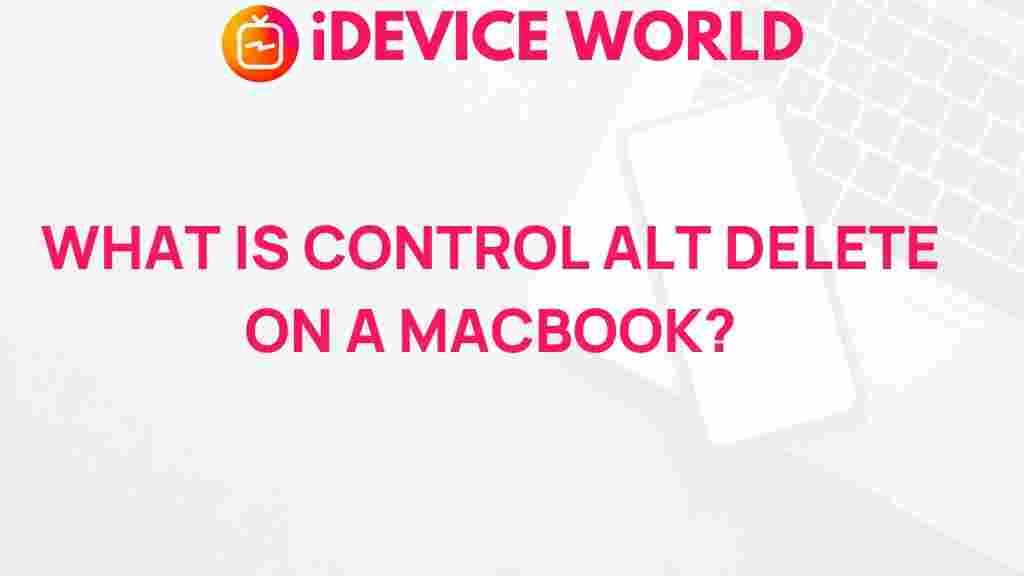Unveiling the Mystery: Control Alt Delete on a MacBook
When it comes to using a MacBook, many users often wonder about the equivalent of the infamous Control Alt Delete function found on Windows computers. This essential command is vital for managing applications and processes effectively. In this article, we will explore what Control Alt Delete means for Mac users, how to perform similar functions, and some troubleshooting tips to enhance your experience.
Understanding the Control Alt Delete Function
The Control Alt Delete command on Windows is primarily used to open the Task Manager, allowing users to manage running applications, processes, and system settings. Mac users may feel at a loss when trying to accomplish similar tasks. However, macOS has its unique set of shortcuts and applications designed to facilitate effective system management.
Mac Equivalent of Control Alt Delete
On a Mac, the equivalent command to Control Alt Delete is Command + Option + Escape. This shortcut opens the “Force Quit Applications” window, allowing users to close unresponsive applications quickly. Here’s how to use it:
- Press and hold the Command (⌘) key.
- While holding the Command key, press the Option key.
- Finally, press the Escape key.
Upon releasing the keys, the “Force Quit Applications” dialog will appear, listing all currently running applications. From here, you can select any unresponsive app and click the “Force Quit” button to close it.
Using Activity Monitor for Advanced Management
For more advanced users, the Activity Monitor app serves as a powerful tool that goes beyond the basic functionality of Control Alt Delete. It provides detailed information about your system’s processes, memory usage, CPU load, and more. Here’s how to access and use Activity Monitor:
- Open Spotlight by pressing Command + Space.
- Type “Activity Monitor” and hit Enter.
- The Activity Monitor window will open, displaying all running processes.
Step-by-Step Guide to Managing Applications on Mac
Here’s a step-by-step guide to managing applications effectively on your MacBook:
Step 1: Force Quit Unresponsive Applications
If an application becomes unresponsive, use the Command + Option + Escape shortcut:
- Select the unresponsive application from the list.
- Click the Force Quit button.
Step 2: Monitor System Performance
To monitor your Mac’s performance, follow these steps:
- Open Activity Monitor as described above.
- Observe CPU, Memory, Energy, Disk, and Network tabs to identify resource usage.
Step 3: Closing Background Processes
To close unnecessary background processes:
- In Activity Monitor, find the process you want to close.
- Select the process and click on the X button in the top-left corner.
- Confirm by clicking Quit or Force Quit if necessary.
Troubleshooting Common Issues
While using MacBook functions akin to Control Alt Delete, users may encounter common issues. Here are some troubleshooting tips:
- Application Won’t Force Quit: If an app won’t close, use Activity Monitor to force quit the process instead.
- Slow Performance: Check for background applications using excessive resources in Activity Monitor and close them if necessary.
- System Freeze: If your Mac freezes completely, hold down the power button until it turns off, then restart.
Keyboard Shortcuts to Enhance Your Experience
Familiarizing yourself with keyboard shortcuts can significantly enhance your MacBook experience. Here are some essential shortcuts:
- Command + Space: Open Spotlight Search.
- Command + Tab: Switch between open applications.
- Command + H: Hide the current application.
Conclusion
Understanding the Mac equivalent of Control Alt Delete is crucial for efficient system management. Whether you are force quitting unresponsive applications or monitoring system performance, MacBook users have various tools at their disposal to ensure a smooth experience. By leveraging keyboard shortcuts and applications like Activity Monitor, you can enhance your productivity and troubleshoot issues effectively.
For more tips on optimizing your Mac experience, visit our resource page or check out Apple’s official support page for detailed guides and troubleshooting tips.
Remember, knowing how to manage your applications effectively can save you time and frustration. So, the next time you think of Control Alt Delete, remember you have the tools to control your Mac just as effectively!
This article is in the category Guides & Tutorials and created by iDeciveWorld Team
